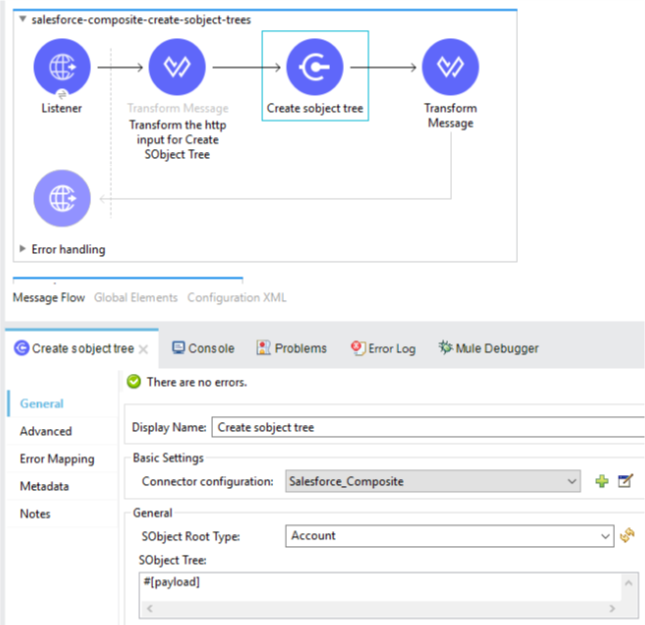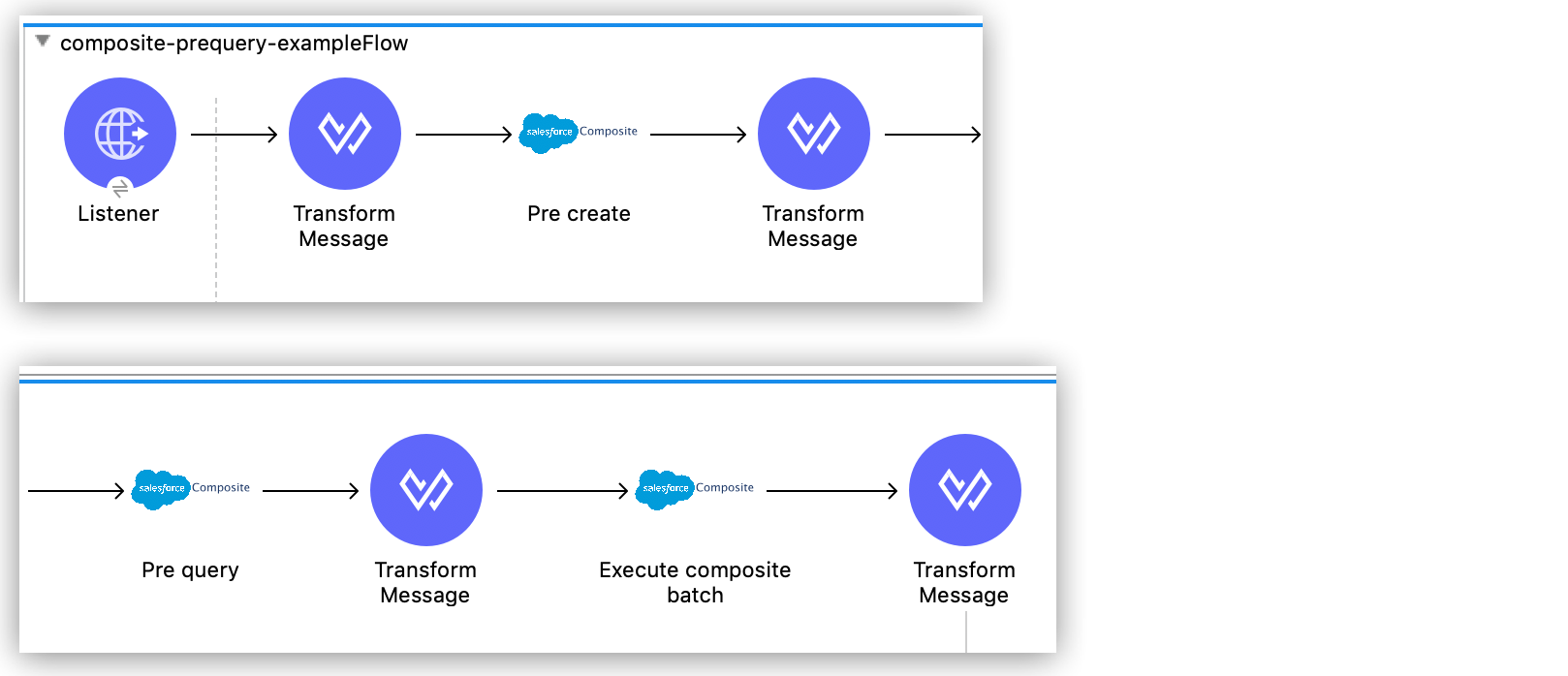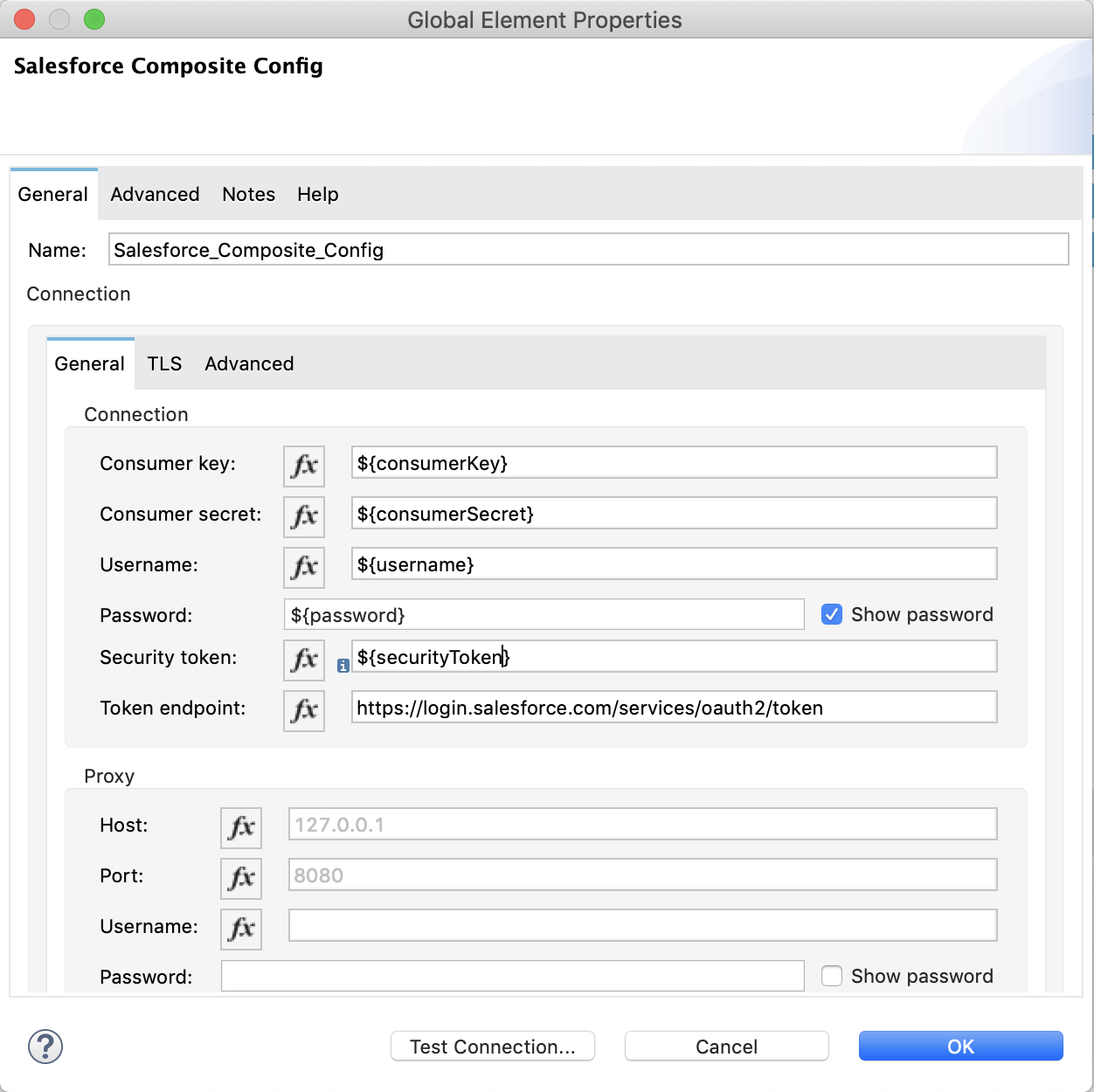
Salesforce Composite Connector 2.20 - Examples
SObject Tree Operation Example
This example uses the following operations to create an SObject tree to connect to Salesforce and transform and output the results in JSON format:
-
HTTP Listener
Accepts data from HTTP requests
-
Transform Message
Transforms the HTTP input
-
Create sobject tree
Connects with Salesforce and creates an SObject tree
-
Transform Message
Outputs the results of the Create sobject tree operation in JSON format

Add an HTTP Listener
The HTTP Listener source operation initiates the flow when it detects an event in the createSObjectTree path. To add the listener and trigger the flow, follow these steps:
-
Create a new Mule project in Studio.
-
In the Mule Palette view, search for
httpand select the Listener operation. -
Drag the Listener operation onto the canvas.
-
In the Listener properties window, set the Path field to
/createSObjectTree.
Add the First Transform Message Component
The first Transform Message component uses input data to transform the HTTP input for the following Create operation. To add the component, follow these steps:
-
In the Mule Palette view, search for Transform Message.
-
Drag the Transform Message component onto the canvas, to the right of Listener.
-
Enter the name
Transform HTTP input for Create SObject Tree.
The following is an example of HTTP input for the Transform Message component:
{
"records":[
{
"ChildAccounts":{
"records":[
{
"Phone":"4321098765",
"Website":"www.salesforce.com",
"attributes":{
"objectType":"Account",
"referenceId":"ref5"
},
"NumberOfEmployees":"10",
"Name":"ChildAccount1"
}
]
},
"Contacts":{
"records":[
{
"Email":"sample@salesforce.com",
"Title":"President",
"attributes":{
"objectType":"Contact",
"referenceId":"ref6"
},
"LastName":"Jones"
}
]
},
"Phone":"5556543210",
"Website":"www.salesforce.com",
"attributes":{
"objectType":"Account",
"referenceId":"ref4"
},
"NumberOfEmployees":"101",
"Name":"CreateSobjectTreeAccount2"
},
{
"Contacts":{
"records":[
{
"Email":"sample@salesforce.com",
"Title":"President",
"attributes":{
"objectType":"Contact",
"referenceId":"ref2"
},
"LastName":"Smith"
},
{
"Email":"sample@salesforce.com",
"Title":"Vice President",
"attributes":{
"objectType":"Contact",
"referenceId":"ref3"
},
"LastName":"Evans"
}
]
},
"Phone":"1234567890",
"Website":"www.salesforce.com",
"attributes":{
"objectType":"Account",
"referenceId":"ref1"
},
"NumberOfEmployees":"100",
"Name":"CreateSobjectTreeAccount1"
}
]
}Add the Create SObject Tree Operation
Add the Create SObject Tree operation to connect with Salesforce and create an SObject tree. To add the operation, follow these steps:
-
In the Mule Palette view, search for
salesforceand select Create sobject tree. -
Drag Create sobject tree operation to the right of Transform Message.
-
Click the green plus sign (+) to the right of Connector configuration to access the Salesforce Composite global element configuration fields.
-
In the Create sobject tree properties window, enter
Accountin the SObject Root Type field. -
In the properties file
src/main/mule/mule-app.properties, declare and enter values for the variables in the global element.
Add the Second Transform Message Component
The second Transform Message component transforms the output result into JSON. To add the component, follow these steps:
-
Drag Transform Message again to the right of Create sobject tree.
-
Enter the following:
%dw 2.0 %output application/json payload --- { "Id": payload.Id, "Fields" : ["Id", "Name"], "Type": "Account" }
XML for the SObject Tree Operation Flow
Paste this XML code into the Configuration XML tab of the Anypoint Studio canvas to experiment with the flow:
<?xml version="1.0" encoding="UTF-8"?>
<mule xmlns:salesforce-composite="http://www.mulesoft.org/schema/mule/salesforce-composite"
xmlns:ee="http://www.mulesoft.org/schema/mule/ee/core"
xmlns:http="http://www.mulesoft.org/schema/mule/http"
xmlns="http://www.mulesoft.org/schema/mule/core"
xmlns:doc="http://www.mulesoft.org/schema/mule/documentation"
xmlns:xsi="http://www.w3.org/2001/XMLSchema-instance"
xsi:schemaLocation="http://www.mulesoft.org/schema/mule/core
http://www.mulesoft.org/schema/mule/core/current/mule.xsd
http://www.mulesoft.org/schema/mule/http
http://www.mulesoft.org/schema/mule/http/current/mule-http.xsd
http://www.mulesoft.org/schema/mule/ee/core
http://www.mulesoft.org/schema/mule/ee/core/current/mule-ee.xsd
http://www.mulesoft.org/schema/mule/salesforce-composite
http://www.mulesoft.org/schema/mule/salesforce-composite/current/mule-salesforce-composite.xsd">
<configuration-properties file="mule-app.properties"/>
<http:listener-config name="HTTP_Listener_config"
doc:name="HTTP Listener config">
<http:listener-connection host="localhost" port="8081" />
</http:listener-config>
<salesforce-composite:composite-config name="Salesforce_Composite_Salesforce_Composite"
doc:name="Salesforce Composite Salesforce Composite">
<salesforce-composite:oauth-user-pass-connection
consumerKey="${consumerKey}"
consumerSecret="${consumerSecret}"
username="${username}"
password="${password}"
securityToken="${securityToken}"
tokenEndpoint="${tokenEndpoint}" />
</salesforce-composite:composite-config>
<flow name="salesforce-composite-create-sobject-trees">
<http:listener doc:name="Listener"
path="/createSObjectTree"
config-ref="HTTP_Listener_config"/>
<ee:transform doc:name="Transform HTTP input for Create SObject Tree">
<ee:message>
<ee:set-payload><![CDATA[%dw 2.0
output application/java
---
payload.records map ((record , indexOfRecord) -> {
"attributes": {
"type": record.attributes.objectType,
"referenceId": record.attributes.referenceId
},
"Name": record.Name,
"Phone": record.Phone,
"Website": record.Website,
"NumberOfEmployees": record.NumberOfEmployees as Number,
("ChildAccounts": {
"records": record.ChildAccounts.records map ((record01, indexOfRecord01) -> {
"attributes": {
"type": record01.attributes.objectType,
"referenceId": record01.attributes.referenceId
},
"Name": record01.Name,
"Phone": record01.Phone,
"Website": record01.Website,
"NumberOfEmployees": record01.NumberOfEmployees as Number
})
}),
"Contacts": {
"records": record.Contacts.records map ((record01, indexOfRecord01) -> {
"attributes": {
"type": record01.attributes.objectType,
"referenceId": record01.attributes.referenceId
},
"LastName": record01.LastName,
"Email": record01.Email,
"Title": record01.Title
})
}
})
]]></ee:set-payload>
</ee:message>
</ee:transform>
<salesforce-composite:create-sobject-tree
doc:name="Create SObject tree"
config-ref="Salesforce_Composite_Salesforce_Composite"
type="Account"/>
<ee:transform doc:name="Transform Message">
<ee:message >
<ee:set-payload ><![CDATA[%dw 2.0
output application/json
---
payload]]></ee:set-payload>
</ee:message>
</ee:transform>
</flow>
</mule>Pre-Query Example
This example provides metadata for an object to query, generates two subrequests that contain this metadata, and then executes the subrequests:
-
HTTP Listener
Accepts data from HTTP requests
-
Transform Message
Specifies a name for the object
-
Pre create
Provides metadata for the object to be created and generates a subrequest used in execution
-
Transform Message
Specifies values for fields
-
Pre query
Provides metadata for the object that is going to be queried and generates a subrequest used in execution
-
Transform Message
Passes output from Pre query operation
-
Execute composite batch
Sends all subrequests in one batch
-
Transform Message
Outputs the results in JSON format

Add an HTTP Listener
The HTTP Listener source operation initiates the flow when it detects an event in the executeFlow path. To add the listener and trigger the flow, follow these steps:
-
Create a new Mule project in Studio.
-
In the Mule Palette view, search for
httpand select the Listener operation. -
Drag the Listener operation onto the canvas.
-
In the Listener properties window, set the Path field to
/executeFlow.
Add the First Transform Message Component
The first Transform Message component specifies a name for the created object and passes the name to the Pre create operation. To add the component, follow these steps:
-
In the Mule Palette view, search for Transform Message.
-
Drag Transform Message onto the canvas, to the right of Listener.
-
Enter the name
MyNewAccount:%dw 2.0 %output application/java --- { Name: "MyNewAccount" }
Add the Pre Create Operation
The Pre Create operation provides metadata for creating an object called NewAccount and generates a subrequest for the executeCompositeBatch operation. To add the operation, follow these steps:
-
In the Mule Palette view, search for
salesforceand select the Salesforce Composite Pre create operation. -
Drag the Pre create operation to the right of Transform Message.
-
Click the green plus icon (+) to the right of the Connector configuration field to access the Salesforce Composite global element configuration fields.
-
In the Pre create properties window, enter
Accountin the Type field. -
In the properties file
src/main/mule/mule-app.properties, declare and enter values for the variables in the global element.

Add the Second Transform Message Component
The second Transform Message component specifies values for the ID and Type fields, and then passes these values to the Pre query operation. To add the component, follow these steps:
-
Drag a second Transform Message component to the right of Pre create.
-
Enter the following name-value pairs:
%dw 2.0 %output application/java --- { "Id": payload.Id, "Fields" : ["Id", "Name"], "Type": "Account" }
Add the Pre Query Operation
The Pre Query operation provides metadata for an object to be queried. It generates a subrequest for the Execute composite batch operation. To add the operation, follow these steps:
-
Drag a Salesforce Composite Pre query operation to the right of the second Transform Message.
-
In the Query field, enter the following:
Select Name from Account WHERE Name LIKE '%:name %'
Add the Third Transform Message Component
The third Transform Message operation passes the output of the Pre query operation to the Execute composite batch operation. To add the component, follow these steps:
-
Drag a third Transform Message component to the right of Pre query.
-
Set the output to
payload:%dw 2.0 %output application/java --- [ payload ]
Add the Execute Composite Batch Operation
The Execute Composite Batch operation executes the subrequests that the Pre Create and Pre Query operations created.
To add the operation, drag a Salesforce Composite Execute composite batch operation to the right of the third Transform Message.
Add the Fourth Transform Message Component
The fourth Transform Message operation converts the output to JSON format. To add the component, follow these steps:
-
Drag a fourth Transform Message component to the right of Execute composite batch.
-
Set the output to
application/json:%dw 2.0 %output application/json --- payload
XML for the Pre-Query Example
Paste this code into your XML editor to quickly load the flow for this example to your Mule app. If needed, change the values to reflect your environment.
<?xml version="1.0" encoding="UTF-8"?>
<mule xmlns:salesforce-composite="http://www.mulesoft.org/schema/mule/salesforce-composite" xmlns:ee="http://www.mulesoft.org/schema/mule/ee/core"
xmlns:http="http://www.mulesoft.org/schema/mule/http"
xmlns="http://www.mulesoft.org/schema/mule/core" xmlns:doc="http://www.mulesoft.org/schema/mule/documentation" xmlns:xsi="http://www.w3.org/2001/XMLSchema-instance" xsi:schemaLocation="http://www.mulesoft.org/schema/mule/core http://www.mulesoft.org/schema/mule/core/current/mule.xsd
http://www.mulesoft.org/schema/mule/http http://www.mulesoft.org/schema/mule/http/current/mule-http.xsd
http://www.mulesoft.org/schema/mule/ee/core http://www.mulesoft.org/schema/mule/ee/core/current/mule-ee.xsd
http://www.mulesoft.org/schema/mule/salesforce-composite http://www.mulesoft.org/schema/mule/salesforce-composite/current/mule-salesforce-composite.xsd">
<http:listener-config name="HTTP_Listener_config" doc:name="HTTP Listener config" >
<http:listener-connection host="0.0.0.0" port="8081" />
</http:listener-config>
<salesforce-composite:composite-config name="Salesforce_Composite_Config" doc:name="Salesforce Composite Config" >
<salesforce-composite:oauth-user-pass-connection consumerKey="${consumerKey}" consumerSecret="${consumerSecret}" username="${username}" password="${password}" securityToken="${securityToken}" />
</salesforce-composite:composite-config>
<flow name="composite-prequery-exampleFlow" >
<http:listener doc:name="Listener" config-ref="HTTP_Listener_config" path="/executeFlow"/>
<ee:transform doc:name="Transform Message" >
<ee:message >
<ee:set-payload ><![CDATA[%dw 2.0
output application/java
---
{
Name: "MyNewAccount"
}]]></ee:set-payload>
</ee:message>
</ee:transform>
<salesforce-composite:pre-create type="Account" doc:name="Pre create" config-ref="Salesforce_Composite_Config">
</salesforce-composite:pre-create>
<ee:transform doc:name="Transform Message" >
<ee:message >
<ee:set-payload ><![CDATA[output application/java
---
{
"Id": payload.Id,
"Fields" : ["Id", "Name"],
"Type": "Account"
}]]></ee:set-payload>
</ee:message>
</ee:transform>
<salesforce-composite:pre-query doc:name="Pre query" config-ref="Salesforce_Composite_Config">
<salesforce-composite:query >Select Name from Account WHERE Name LIKE '%:name %'
</salesforce-composite:query>
<salesforce-composite:parameters ><![CDATA[#[output application/java
---
{
"name" : "MyNewAccount"
}]]]></salesforce-composite:parameters>
</salesforce-composite:pre-query>
<ee:transform doc:name="Transform Message" >
<ee:message >
<ee:set-payload ><![CDATA[%dw 2.0
output application/java
---
[
payload
]]]></ee:set-payload>
</ee:message>
</ee:transform>
<salesforce-composite:execute-composite-batch doc:name="Execute composite batch" config-ref="Salesforce_Composite_Config"/>
<ee:transform doc:name="Transform Message" >
<ee:message >
<ee:set-payload ><![CDATA[%dw 2.0
output application/json
---
payload]]></ee:set-payload>
</ee:message>
</ee:transform>
</flow>
</mule>


